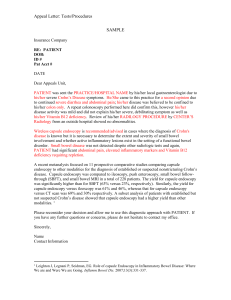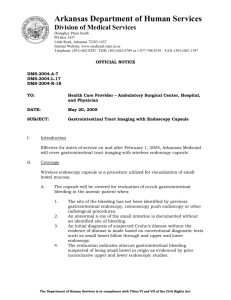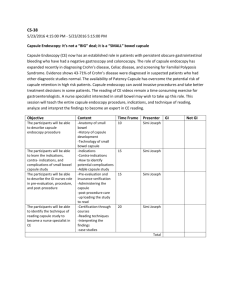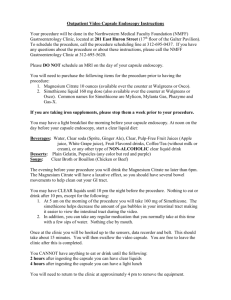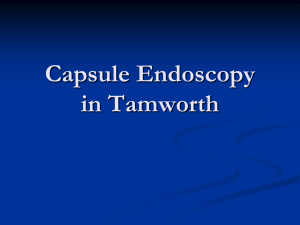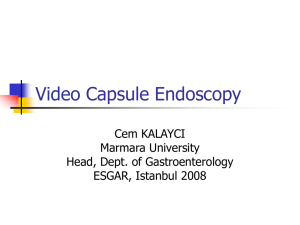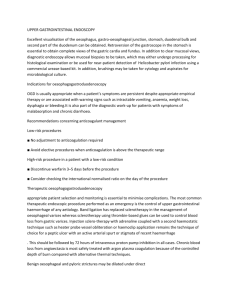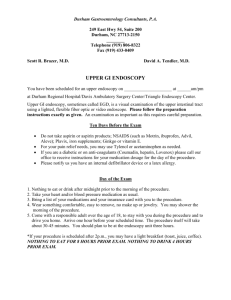Olympus Capsule Endoscopy for Small Bowel Examination
advertisement
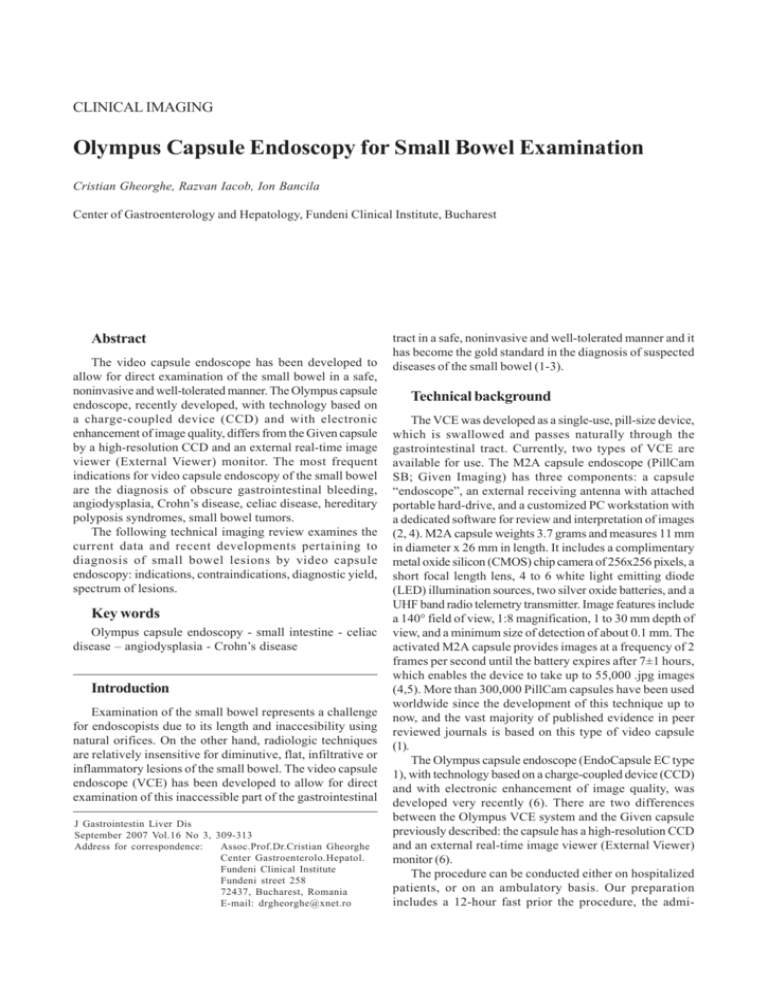
Video capsule endoscopy for small bowel examination CLINICAL IMAGING Olympus Capsule Endoscopy for Small Bowel Examination Cristian Gheorghe, Razvan Iacob, Ion Bancila Center of Gastroenterology and Hepatology, Fundeni Clinical Institute, Bucharest Abstract The video capsule endoscope has been developed to allow for direct examination of the small bowel in a safe, noninvasive and well-tolerated manner. The Olympus capsule endoscope, recently developed, with technology based on a charge-coupled device (CCD) and with electronic enhancement of image quality, differs from the Given capsule by a high-resolution CCD and an external real-time image viewer (External Viewer) monitor. The most frequent indications for video capsule endoscopy of the small bowel are the diagnosis of obscure gastrointestinal bleeding, angiodysplasia, Crohn’s disease, celiac disease, hereditary polyposis syndromes, small bowel tumors. The following technical imaging review examines the current data and recent developments pertaining to diagnosis of small bowel lesions by video capsule endoscopy: indications, contraindications, diagnostic yield, spectrum of lesions. Key words Olympus capsule endoscopy - small intestine - celiac disease – angiodysplasia - Crohn’s disease Introduction Examination of the small bowel represents a challenge for endoscopists due to its length and inaccesibility using natural orifices. On the other hand, radiologic techniques are relatively insensitive for diminutive, flat, infiltrative or inflammatory lesions of the small bowel. The video capsule endoscope (VCE) has been developed to allow for direct examination of this inaccessible part of the gastrointestinal J Gastrointestin Liver Dis September 2007 Vol.16 No 3, 309-313 Address for correspondence: Assoc.Prof.Dr.Cristian Gheorghe Center Gastroenterolo.Hepatol. Fundeni Clinical Institute Fundeni street 258 72437, Bucharest, Romania E-mail: drgheorghe@xnet.ro tract in a safe, noninvasive and well-tolerated manner and it has become the gold standard in the diagnosis of suspected diseases of the small bowel (1-3). Technical background The VCE was developed as a single-use, pill-size device, which is swallowed and passes naturally through the gastrointestinal tract. Currently, two types of VCE are available for use. The M2A capsule endoscope (PillCam SB; Given Imaging) has three components: a capsule “endoscope”, an external receiving antenna with attached portable hard-drive, and a customized PC workstation with a dedicated software for review and interpretation of images (2, 4). M2A capsule weights 3.7 grams and measures 11 mm in diameter x 26 mm in length. It includes a complimentary metal oxide silicon (CMOS) chip camera of 256x256 pixels, a short focal length lens, 4 to 6 white light emitting diode (LED) illumination sources, two silver oxide batteries, and a UHF band radio telemetry transmitter. Image features include a 140° field of view, 1:8 magnification, 1 to 30 mm depth of view, and a minimum size of detection of about 0.1 mm. The activated M2A capsule provides images at a frequency of 2 frames per second until the battery expires after 7±1 hours, which enables the device to take up to 55,000 .jpg images (4,5). More than 300,000 PillCam capsules have been used worldwide since the development of this technique up to now, and the vast majority of published evidence in peer reviewed journals is based on this type of video capsule (1). The Olympus capsule endoscope (EndoCapsule EC type 1), with technology based on a charge-coupled device (CCD) and with electronic enhancement of image quality, was developed very recently (6). There are two differences between the Olympus VCE system and the Given capsule previously described: the capsule has a high-resolution CCD and an external real-time image viewer (External Viewer) monitor (6). The procedure can be conducted either on hospitalized patients, or on an ambulatory basis. Our preparation includes a 12-hour fast prior the procedure, the admi- 310 nistration of 2 liters of polyethylene glycol (PEG) solution in the evening and 1 liter 30 minutes before the procedure. The use of prokinetic agents (10 mg of metoclopramide) is optional in patients with slow gastric transit. Metoclopramide decreases gastric transit time and was recently shown to increase the likelihood of successful small bowel examination (7). In contrast, erythromycin had no significant effect on capsule propulsion in the small bowel (8). Patients are allowed to drink clear liquids 2 hours after ingestion of the capsule and to eat a light meal 4 hours after ingestion. The Olympus EndoCapsule software provides a complex antenna consisting of eight antennas combined into one. The antenna receiving the strongest signal is highlighted and serves for the localization of capsule’s position in the gastrointestinal tract. The technology is considered imprecise, and locating the position of the capsule in the abdomen is judged considering also the mucosal patterns of the jejunum and ileum, the time elapsed from the start of the examination, and checking directly the capsule images during the procedure using the Olympus External Viewer (1). The VCE software of Olympus EndoCapsule has a “multiview” capability added for reading the VCE recordings. This allows for the simultaneous display in adjacent windows of four consecutive images from the VCE recordings. The Olympus EndoCapsule also includes software that detects the color red, which may help to identify bleeding in the small bowel. Clinical applications 1. Obscure gastrointestinal bleeding The primary and most frequent indication for VCE of the small bowel is the diagnosis of obscure gastrointestinal bleeding. Obscure gastrointestinal bleeding represents approximately 5% of all gastrointestinal bleeds (9). It is defined as recurrent or persistent gastrointestinal bleeding despite the absence of explanatory findings at initial upper and lower endoscopy (10). Obscure gastrointestinal bleeding can be subclassified as either obscure-overt or obscure-occult bleeding, based on the history of gross gastrointestinal bleeding symptoms (melena or hematochezia). Obscure-occult gastrointestinal bleeding can be manifested by recurrent iron deficiency anemia, or by positive fecal occult blood test. The diagnostic yield reaches 92.3% for patients with ongoing-overt bleeding compared with 44.2% for obscure-occult bleeding and 12.9% for past bleeding (11). A recent consensus algorythm (12) suggest that VCE should be considered the first-line investigation for obscure bleeding, although second-look traditional endoscopy represents a reasonable approach, because up to 30% of lesions can be missed on the initial evaluation (13). Angiodysplasia (29%) (Fig.1), followed by unsuspected Crohn’s disease (6%) are the most frequent lesions which cause obscure gastrointestinal bleeding (14). Gheorghe et al Based on the findings from a recent study (15), the optimal timing for VCE investigation in obscure gastrointestinal bleeding is within the first few days post bleeding episode until a maximum waiting time of 2 weeks. 2. Crohn’s disease VCE has a high yield in detection of small bowel lesions in Crohn’s disease, allowing the diagnosis in a subset of patients with clinical suspicion but negative upper and lower endoscopy, including terminal ileum intubation (1). The diagnostic yield for this indication ranges from 43 to 71%, and according to recent studies VCE was superior to push endoscopy (16) and enteroclysis (16,17). Because of the increased sensitivity of VCE compared with push enteroscopy and enteroclysis, it was designated as goldstandard examination for the diagnosis of small bowel Crohn’s disease (18). A meta-analysis of 9 prospective trials suggest a yield of 66% for VCE vs 24% for small bowel radiography and 46% for ileoscopy (19). Potential indications for the use of VCE in patients with suspected or established Crohn’s disease are: 1) suspected Crohn’s disease with negative upper endoscopy and colonoscopy; 2) evaluation of patients with indeterminate colitis; 3) evaluation of response to anti-inflammatory therapy, if indicated (20). There are few contraindications for VCE: 1) clinical or radiographic evidence of bowel obstruction; 2) extensive and active Crohn’s disease of the small bowel, with or without strictures; 3) intestinal pseudoobstruction; 4) extensive intestinal diverticulosis; 5) children under the age of 10 (20). The risk for VCE retention in patients with Crohn’s disease is estimated to 5% (1). The spectrum of lesions in the small bowel in Crohn’s disease ranges from erythema to aphtous, stellate or large ulcerations or fistulae (20) (Figs.2,3). There are more than 40 pathological conditions in which small bowel erosions or ulcers may be found. It is, therefore, important to exclude these conditions before the final diagnosis of Crohn’s disease is made. Erosions and ulcers of the small bowel may result from other causes/diseases such as NSAID intake (Fig.4), lymphoid hyperplasia, lymphoma, radiation enteritis, HIV with opportunistic infection, intestinal tuberculosis and Behcet’s disease. Finally, the diagnosis of Crohn’s disease should be based on the combination of clinical data and relevant findings of VCE (18). 3. Celiac disease Capsule endoscopy technology, with its magnification capacity of 1:8 and images taken very close to the mucosa, can provide good quality images of the small bowel, including the villi. The International Conference of Capsule Endoscopy has reached a consensus regarding the role of VCE in the diagnosis and complications of celiac disease (21). Capsule endoscopy may be useful in diagnosing celiac disease in patients with new or persistent symptoms or suggestive serological markers for celiac disease who are unwilling or unable to undergo an upper gastrointestinal endoscopy. The abnormalities detected include primary diagnostic changes in small bowel mucosa (endoscopic Video capsule endoscopy for small bowel examination 311 Fig.1 Angiodysplastic lesion of the small bowel mucosa. Fig.5 Celiac disease: Scalloping of folds. Fig.2 Crohn’s disease: small bowel ulcers. Fig.6 Celiac disease: Mosaic appearance of the small bowel mucosa. Fig.3 Crohn’s disease: aphtoid lesion. Fig.7 Celiac disease: Flat mucosa with visible vessels. Fig.4 Small ulcerations after NSAID ingestion. Fig.8 Celiac disease: Abnormal villi, thickened and shortened. 312 Gheorghe et al Fig.9 Celiac disease: Layering or stacking of folds. Fig.10 Celiac disease: Nodular appearance of the small bowel mucosa. Fig.11 Familial adenomatous polyposis: small adenomatous polyp in the small bowel. terminology used to describe villous atrophy is also applied to VCE: scalloping (Fig.5), fissuring, mosaic pattern (Fig.6), flat mucosa (Fig.7), abnormal villi – shortened and thickened (Fig.8), layered or stacked folds (Fig.9), loss of circular folds and nodularity (Fig.10) (22,23), and complications related to celiac disease such as ulcerative jejuno-ileitis, enteropathyassociated T-cell lymphoma and adeno-carcinoma of the small bowel (24,25). The sensitivity and specificity of VCE for recognizing villous atrophy is 70% and 100%, respectively. For diagnosing complications of long standing celiac disease (lymphoma, ulcerative jejunitis, adenocarcinoma), VCE should be performed early in patients who develop evoking symptoms such as diarrhea, abdominal pain, fever, or evidence of gastrointestinal bleeding (23). Candidates for surveillance for malignancy include elderly patients recently diagnosed with celiac disease (increased risk for lymphoma), as well as individuals diagnosed in childhood who are reconfirmed as adults (increased risk for adenocarcinoma) (26). 4. Hereditary polyposis syndromes Many gastrointestinal polyposis syndromes include small bowel polyps as part of clinical presentation. 30% to 50% of patients with severe polyposis will develop small bowel adenocarcinomas. VCE is a simple, safe and noninvasive procedure for the detection of small bowel polyps related to hereditary polyposis syndromes (Fig.11). Growing evidence confirms the usefulness of this technique for detecting polyps in selected patients with familial adenomatous polyposis, who have an increased risk of developing polyps in the distal part of the small bowel (patients with severe duodenal polyposis, 2-4 Spigelman score) (28-30), and as first-line procedure in patients with Peutz-Jeghers syndrome (31). VCE has been found to have higher, respectively similar accuracy as compared with barium studies and magnetic resonance imaging (MRI) for the detection of large polyps (>15 mm) in patients with hereditary polyposis syndromes. However, the detection rate for small (5-15 mm diameter) and diminutive (<5 mm) polyps is much higher with VCE (27). Schulmann et al recently showed that approximately 20% of patients with hereditary polyposis syndromes had polyps in the distal jejunum or ileum that were beyond the reach of upper and lower traditional endoscopy, detected only by VCE (28). 5. Small bowel tumours The most common indication for VCE in patients with small bowel tumours is obscure gastrointestinal bleeding (80%) (Fig.12). The majority of detected small bowel tumors are malignant (60%), consisting of adenocarcinomas, melanomas, carcinomas, lymphomas, and sarcomas. The benign small bowel tumours (40%) are gastrointestinal stromal tumors, hemangiomas, hamartomas, and adenomas (1). Fig.12 Bleeding tumor in the terminal ileum. 6. Miscellaneous Various small bowel lesions have been described using VCE: Meckel’s diverticulum, tuberculosis, Ascaris infection, Video capsule endoscopy for small bowel examination and aortoduodenal fistulae. VCE was also used in some centers for the assessment of bowel in post transplant recipients, unexplained abdominal pain and diarrhea (1). In addition to enhanced resolution of the CCD-captured endoscopic images, the real time image interpretation on a LCD display could be useful for detecting the gastric transit abnormality as well as for increasing the likelihood of a complete small bowel examination in patients undergoing Olympus VCE system (6,32). Disclosure There are no conflicts of interest. Grant This study was supported by a research grant of the Romanian Ministry of Research - VIASAN 428/2004 (COLOCANS). References 1. Rey JF, Ladas S, Alhassani A, Kuznetsov K, and the ESGE Guidelines Committee. European Society of Gastrointestinal Endoscopy (ESGE). Video capsule endoscopy: update to guidelines (May 2006). Endoscopy 2006; 38: 1047-1053 2. Ginsberg GG, Barkun AN, Bosco JJ et al. Wireless capsule endoscopy (August 2002). Gastrointest Endosc 2002; 56: 621624 3. Leighton JA, Goldstein J, Hirota W, et al. Standards of Practice Committee of the American Society for Gastrointestinal Endoscopy. Obscure gastrointestinal bleeding. Gastrointest Endosc 2003; 58: 650-655 4. Cave DR. Reading wireless video capsule endoscopy. Gastrointest Endosc Clin N Am 2004; 14: 17-24 5. Lewis B. Capsule endoscopy – transit abnormalities. Gastrointest Endosc Clin N Am 2006; 16: 221-228 6. Rey JF, Kuznetsov K, Vazquez-Ballesteros E. Olympus capsule endoscope for small and large bowel exploration. Gastrointest Endosc 2006; 63: AB176 (Abstract M1340) 7. Selby W. Complete small-bowel transit in patients undergoing capsule endoscopy: determining factors and improvement with metoclopramide. Gastrointest Endosc 2005; 61: 80-85 8. Caddy GR, Moran L, Chong AK, Miller AM, Taylor AC, Desmond PV. The effect of erythromycin on video capsule endoscopy intestinal-transit time. Gastrointest Endosc 2006; 63: 262-266 9. Lewis BS. Small intestinal bleeding. Gastroenterol Clin North Am 1994; 23: 67-91 10. American Gastroenterological Association medical position statement: evaluation and management of occult and obscure gastrointestinal bleeding. Gastroenterology 2000; 118:197-201 11. Fireman Z. The light from the beginning to the end of the tunnel. Gastroenterology 2004; 126: 914-916 12. Penazzio M, Eisen G, Goldfarb N; ICCE. ICCE consensus for obscure gastrointestinal bleeding. Endoscopy 2005; 37: 10461050 13. Eisen GM. Capsule endoscopy indication. ASGE Clinical Update 2006; 14: 1-4 14. Pennazio M, Santucci R, Rondonotti E, et al. Outcome of patients with obscure gastrointestinal bleeding after capsule 313 endoscopy: report of 100 consecutive cases. Gastroenterology 2004; 126: 643-653 15. Bresci G, Parisi G, Bertoni M,Tumino E, Capria A. The role of video capsule endoscopy for evaluating obscure gastrointestinal bleeding: usefulness of early use. J Gastroenterol 2005; 40: 256-259 16. Chong AK, Taylor A, Miller A, Hennessy O, Connell W, Desmond P. Capsule endoscopy vs. push enteroscopy and enteroclysis in suspected small bowel Crohn’s disease. Gastrointest Endosc 2005; 61: 255-261 17. Marmo R, Rotondano G, Piscopo R, et al. Capsule endoscopy versus enteroclysis in the detection of small bowel involvement in Crohn’s disease: a prospective trial. Clin Gastroenterol Hepatol 2005; 3: 772-776 18. Bar-Meir S. Review article: Capsule endoscopy – are all small intestinal lesions Crohn’s disease? Aliment Pharmacol Ther 2006; 24 (Suppl 3): 19-21 19. Triester SL, Leighton JA, Leontiadis GI, et al. A meta-analysis of the yield of capsule endoscopy compared to other diagnostic modalities in patients with non-stricturing small bowel Crohn’s disease. Am J Gastroenterol 2006; 101: 954-964 20. Papadakis KA, Lo SK, Fireman Z, Hollerbach S. Wireless capsule endoscopy in the evaluation of patients with suspected or known Crohn’s disease. Endoscopy 2005; 37: 1018-1022 21. Cellier C, Green PH, Collin P, Murray J; ICCE. ICCE consensus for celiac disease. Endoscopy 2005; 37: 1055-1059 22. Petroniene R, Dubcenco E, Baker JP, et al. Given capsule endoscopy in celiac disease: evaluation of diagnostic accuracy and interobserver agreement. Am J Gastroenterol 2005; 100: 685-694 23. Green PH, Rubin M. Capsule endoscopy in celiac disease: diagnosis and management. Gastrointest Endosc Clin N Am 2006; 16: 307-316 24. Culliford A, Daly J, Diamond B, Rubin M, Green PH. The value of wireless capsule endoscopy in patients with complicated celiac disease. Gastrointest Endosc 2005; 62: 55-61 25. Daum S, Wahnschaffe U, Glasenapp R, et al. Capsule endoscopy in refractory celiac disease. Endoscopy 2007; 39: 455-458 26. Rampertab SD, Forde KA, Green PH. Small bowel neoplasia in coeliac disease. Gut 2003; 52: 1211-1214 27. Mata A, Llah J, Castells A, et al. A prospective trial comparing wireless capsule endoscopy and barium contrast series for small bowell surveillance in hereditary GI polyposis syndromes. Gastrointest Endosc 2005; 61: 721-725 28. Schulmann K, Hollerbach S, Kraus K, et al. Feasibility and diagnostic utility of video capsule endoscopy for the detection of small bowel polyps in patients with hereditary polyposis syndromes. Am J Gastroenterol 2005; 100: 27-37 29. Burke A, Santisi J, Church J, Levinthal G. The utility of capsule endoscopy small bowel surveillance in patients with polyposis. Am J Gastroenterol 2005; 100: 1498-1502 30. Spigelman AD, Williams CB, Talbot IC, Domizio P, Phillips RK. Upper gastrointestinal cancer in patients with familial adenomatous polyposis. Lancet 1989; 2: 783-785 31. Brown G, Fraser C, Schofield G, et al. Video capsule endoscopy in Peutz-Jeghers syndrome: a blinded comparison with barium follow-through for detection of small-bowel polyps. Endoscopy 2006; 38:385-390 32. Ogata H, Kumai K, Imaeda H, et al. Clinical impact of a newlydeveloped capsule endoscope: usefulness of a real-time image viewer against gastrointestinal transit abnormality. Gastrointest Endosc 2006; 63: AB177 (Abstract M1343)
